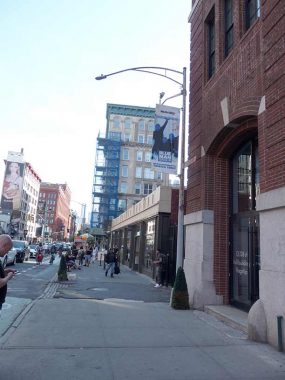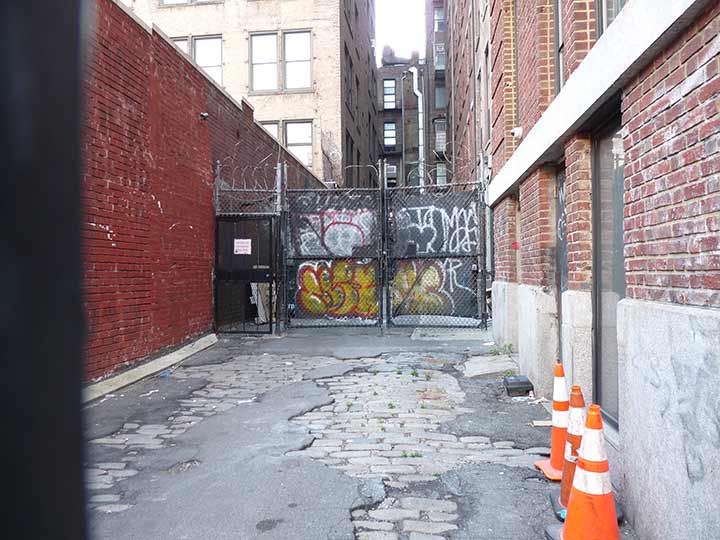
I have mentioned Jones Alley on NoHo a number of times over the years. I have a fascination with it because it’s fenced off on both ends and I can’t enter it; all I can do is get images of it from its intersections. It bends not once but twice, intersecting four streets along its route. According to Gil Tauber of oldstreets, in 1806 a laneway called at first Cross Lane was laid out beginning at Bleecker opposite Mott. It ran north to the middle of the block, then west to a point about 150 feet east of Broadway, then north again, crossing Bond and Great Jones Street to a dead end about 45 feet south of East 4th Street. Lafayette Street (laid out in the first decade of the 20th Century) later cut the alley into two L-shaped sections.
No one is sure exactly when but Cross Lane was renamed in honor of Samuel Jones, a prominent lawyer popularly known as the “Father Of The New York Bar” in the late 1700s. Jones also served as New York City’s first comptroller.
Jones originally owned the land on which Great Jones Street runs. When he deeded the land to the city he demanded the city named any street opened through the grant for him, as part of the agreement. Because the city already had a Jones Street to the west in Greenwich Village, it was decided to call it Great Jones Street because it was wider (In the 1800s, “great” also meant “large”, a meaning that the word no longer has, though “greater” can mean “larger.”) Jones Alley, also in Samuel Jones’ old property, was also named for him. I’m not sure if it was ever called “Great Jones Alley.”
At some time in the past, the part of Jones Alley east of Lafayette Street came to be called Shinbone Alley. The part west of Lafayette Street is Jones Alley. When I began photography for Forgotten New York, there was a street sign mounted on a pole for Shinbone alley, but apparently it was stolen so often the Department of Transportation gave up.

Well into the 1990s the lamppost that illuminated the corner of Lafayette and Jones Alley carried a Westinghouse AK-10 “cuplight.” Note the unusual positioning of the post next to the building. The Department of Transportation occasionally does this in areas where deliveries take place to lessen the possibilities of truck-lamppost accidents. A spotlight is affixed to the post, shining on this section of Jones Alley. Pictured above is the view from Lafayette, showing a bit of original Belgian block pavement.
Jones Alley is now afforded no street signage, but till recently one was located on this lamppost.
In 2007, photographer Pat Cullinan managed to get behind the gates, and shot several Jones Alley images you can see on this FNY page.
Lastly, the slang term “jones,” meaning an addiction to drugs, is said to have originated among addicts who lived in Jones Alley.
As always, “comment…as you see fit.” I earn a small payment when you click on any ad on the site. Take a look at the new JOBS link in the red toolbar at the top of the page on the desktop version, as I also get a small payment when you view a job via that link.
12/10/24


1 comment
Prior to the early 1980’s when the great American jobs giveaway (sorry, I meant globalization) began, the Human Resources Administration had only three homeless shelters. There was the notorious Men’s shelter at 8 east Third street, the flophouse around the corner at 333 Bowery, and the Women’s shelter at 350 Lafayette, adjacent to Jones Alley. To give you some idea of the clientele of the womens shelter, I was working on an exhaust fan motor on the roof recreational area. A women came over and handed me a long letter that stated she had lived on a farm in Idaho and had been abducted by aliens who brought her NYC and deposited her on the roof of the shelter.
By 1981 things had gotten pretty bad around the shelter. Despite the floodlight mounted on the street light pole, the nefarious things going on in Jones Alley raised the ire of the neighbors, and they complained to their City Council person. The complaint wound up getting to electric shop very fast. The electrical supervisor had us install a 1000 watt high pressure sodium floodlight on the side of the building near the roof aimed down into the alley. This floodlight gave off three times the light that the standard 400 watt sodium streetlight then in common use. The alley was lit up like it was noontime. Within two days another complaint came from the council person that her constituents couldn’t sleep because of the light shining in their windows.
Perhaps Mr. Mulero has a photo of that street light from the 70’s? My memory is starting to fail, but I thought the floodlight was originally mounted on top of the AK-10?